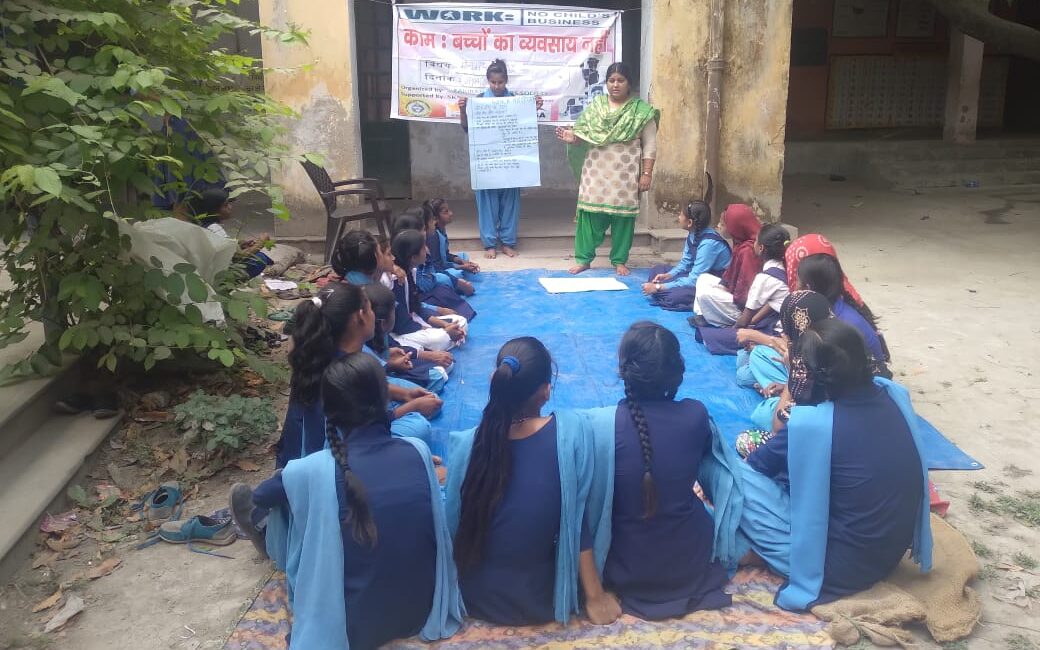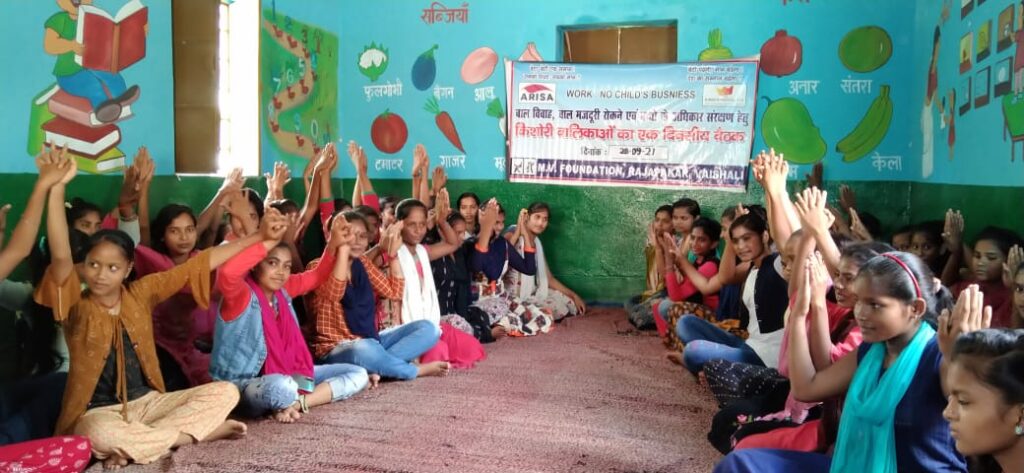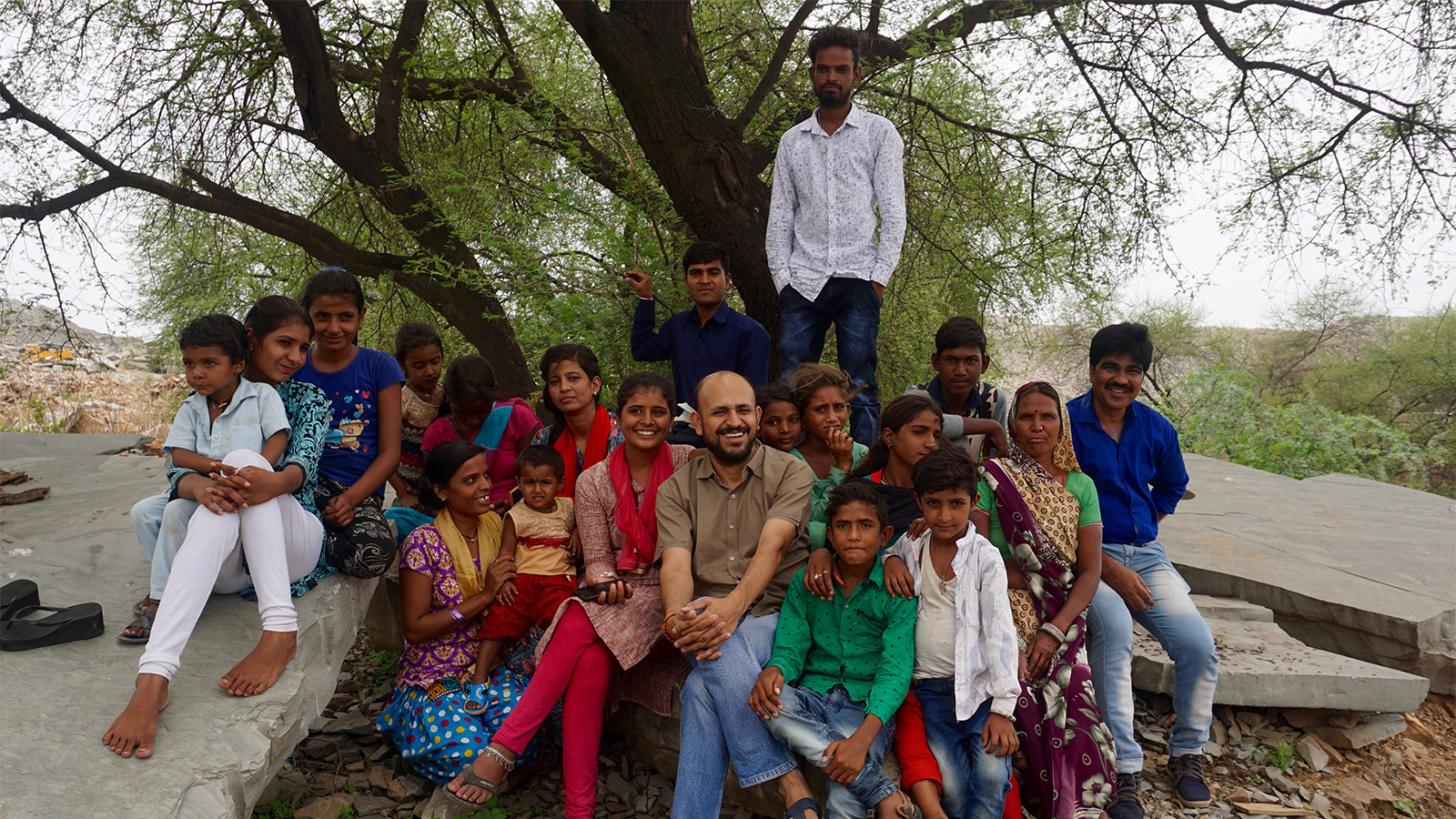Strategies
Community mobilisers work with a set of strategies: researching and gaining in-depth knowledge about the context and situation in the community and the family, home visits and building trust, interaction with children and community meetings. In addition they implement tailor-made interventions that fit within the context and needs of the community.
Together with their team, they discuss the situation of children and families in a community and decide what strategies to use. They discuss the progress they have made, the challenges and setbacks they have faced, so they can support and learn from eachother.
Below examples of these basic strategies and tailor-made interventions.
Home visits
Community mobilisation by WNCB partners involves regular home visits. Getting to know the families, building a relationship and gaining trust is an indispensable part of community mobilisation. It takes time and patience, and a lot of commitment from the mobilisers, who are often met with caution or even hostility on their first visits.
During home visits, mobilisers talk to the parents and sometimes spend time with the children. In many cases they visit the families every day in order to build up a good relationship. They cannot meddle in families’ lives and livelihoods. This means they don’t jump straight to the point when they first meet, but take their time to build trust.
“When we go to visit families and children, we don’t tell them right away what our goal is – that we want to help them go to school. This could lead to immediate resistance. We have to build a relationship with the families and the children, and that takes time. Once the relationship has been built, we can start promoting education and the idea of going to school.”
Mobilisers collect information within their community. They know which children do not go to school or are at risk of dropping out, know which families need support.
”I go from house to house to collect the names of the children who are not going to school so that I can help send them to school. I take the children to schools to arrange admission, keep holding meetings in the village to sensitise families, women and children about going to school and I try to motivate the children to go to school”.
Interaction with the children
Not only talking and building trust with the parents is part of the strategy to get children (back) into school, also the children themselves are important actors in the work of the mobilisers. If children are enthusiastic about the idea of going to school, this will help to win over their parents and other adults in the community. Interacting and engaging with children can also increase retention rates and encourage drop-outs to return to school. Mobilisers interact with children to make them more enthusiastic and curious about education. They give the children a sense of visibility and self-confidence, so that they too feel that they should be in school and can dream of becoming more.
“To familiarise them with us, we first give the children something to play with, such as games or a football. The kind of game-based materials we give them are the same ones they use and have in school. Most of these children don’t have toys and games at home. We explain that they can also find games and toys at school.”
“We also organise various workshops for the children to motivate them about education and going to school. Some of these workshops are specifically for school dropouts, mostly girls. We want to motivate the dropouts to go back to school, as especially girls are at high risk of child labour and child marriage if they are not in school.”
”At the beginning of my work as a mobiliser in my blocks, I had no connection with the children there. When we did a field survey, they would not come and talk to me. I had to gain the children’s trust. So, during the course of the year, I tried to talk to the children every single day. The progress was very slow, and it was a difficult process, but I continued to talk to them on a daily basis. There were about 10 or 11 children going to school when I started working as a mobiliser in this block. But after all the hard work, there are now between 200 and 300 children in school.”
Community meetings
Mobilising communities, as the name suggests, involves the whole community. It goes beyond convincing and involving parents and families. For children to go to school and stay in school, all people and stakeholders in a community need to believe and support the idea that all children must go to school. To reach the whole community, mobilisers attend meetings of groups in the community, such as women’s groups, school committees and workers’ meetings, and also organise meetings for these different groups.
”In the village where I work, there are different groups with whom we conduct meetings. We use these meetings to sensitise the people about child labour, child marriage, trafficking, and more topics like these. We also organise meetings with stakeholders such as restaurant owners and talk to teachers and school headmasters about the issues with child labour in our area.”
”In each school, there is a School Management Committee (SMC). People from the village are in this committee. We are continuously in dialogue with the SMC to keep track of the children in our village and to monitor if they are attending school or not. We regularly organise meetings with the SMC and other groups in the village to talk about the dropout issues of the children.”
“We keep sensitising people in the communities, talking to them, visiting them and visiting the children and others in the community. Slowly, some people in the community start listening to us. Not 100 percent of people listen to what we try to tell them, but after a while, some families trust us and change their perspective.”



Support with school admission and materials
Community mobilisers help children enrol in school. When parents are uneducated or illiterate, it is difficult for them to understand the enrolment process. In such cases, they are not familiar with the process or are not able to read the documents. The mobilisers go to great lengths to ensure a successful enrolment. Among other things, they talk to teachers and headmasters, organise the correct identification papers for the children, and if necessary help them with the required school uniform and materials. They remove the obstacles of enrolment for the parents.
“All the children had to have a school uniform, the right stationery and they had to attend school every day for one month as a trial month. The teachers would decide whether or not to allow the children to attend school after this trial month. Dalit families are very poor, so MV Foundation helped by providing uniforms and stationery. We also literally helped them get to school; we’d collect them from home in the morning, make sure they looked presentable, had their stationery, uniforms and took them to school. We made sure that the children attended their classes for the whole month. All of these children had never been to school. Their parents and other family members had never received any education either. So when the children started school, their basic knowledge was very low. That is why I started to teach the children some of the basic things that they needed to know before they started to go to school.”
”We help families and their children with school admission. We put a lot of effort into this as many children don’t have any official documents such as identification or a birth certificate. With the help of the schools, we can arrange school admission for the children. We then keep promoting these children in the schools with the teachers and headmasters to ensure retention.”
Bridge courses and training
Not only enrolment in school is part of the mobilisers’ strategies, also to ensure retention. Mobilisers work with parents, schools and teachers to make sure children are accepted and stay in school. They use bridge courses and training as important tools for school attendance and retention. In bridge course programmes, mobilisers tutor children outside of school hours. In some cases this is done in bridging school centres, in others mobilisers tutor children in their homes.
During the bridge course, they help the children complete their schoolwork and check their work. Mobilisers enable children to keep up with the level required at school. In a bridge course programme, a child can have individual tuition in subjects that need extra attention. During bridge courses, mobilisers build children’s confidence. When school is easier, it is more fun! So, bridge course programmes increase the retention of children already in school and also help newly enrolled children to adjust to the school system and their (age-appropriate) level.
“To ensure retention, we have a bridge course programme. In this programme, our mobilisers teach the children outside of school-hours. In the bridge course centers, our mobilisers help children to complete their school tasks and review their work. This reduces the number of children that drop out of school and makes it easier for children who have never gone to school to adjust to the school systems. We create special classes for children to keep them updated with the school standards. This is important for the school retention and for the children’s confidence and self-image. Our mobilisers practise with these children to make sure they can keep up with school, feel good about themselves, and don’t drop out.”
”We also promote computer training for the children. Many children have already benefited from the computer trainings. Not only school going children, but also children who have actually dropped out.”
“Migration is especially an issue with the children between the age of 14 to 18. When they see that other children their age migrate to work, they tend to copy each other and leave too. They for example move to Gujarat or Mumbai, and when they return to our village, have smartphone and good clothes. This ‘encourages’ other children to migrate too. So, we try to prevent children in this age group from migrating and working. One strategy we use is to promote our computer centres amongst them. Learning how to use a computer will increase the chances of them getting an education. When the children learn a skill, as an adult, they can get different opportunities and better jobs in the communities and villages where they are from.”
In Delhi, mobilisers also use a so-called ‘Multi Activity Centre’ to help getting children into school.
“The MAC centre is very attractive for the children because we have play-based materials. Children from these poor families don’t have toys and these kind of things at home. So, in a way, the MAC centre works like a magnet to them. It is very fun for them to visit the centre: here they can play, while at home, they have to work. Once the children have visited us, they will want to come here more often. We don’t have to pressure them to come because they like coming here.”
Livelihood opportunities
A common theme is poverty. As one of India’s poorest states, Bihar is noted for its institutional and technical deficiencies, very high illiteracy and lack of proper health care and education. Part of the strategy of concerned organisations and mobilisers is to devise and help set up new livelihood opportunities for parents. Livelihood programmes and skills training help them create new job opportunities specific to their community and area and that do not involve their children.
Bihar is one of the poorest states in India and is known for its institutional and technical deficiencies, very high illiteracy rate and lack of proper health care and education. Poverty in Bihar is one of the causes of child labour. It forces children to work and, conversely, child labour perpetuates poverty. It is a vicious circle that is detrimental to the community as a whole. Part of the strategy of the organisations and mobilisers involved is to develop and help create new livelihood opportunities for parents. Livelihood programmes and skills training help parents create new job opportunities specific to their community and area. For example, they look at new opportunities in farming, running a shop, or rearing livestock. When parents can earn more through work, they are more receptive to the idea that their child should and can go to school.
‘’People are uneducated and there is so much poverty. So when we try to tell people that they shouldn’t send their children to migrate for work or have a child marriage or work alongside them, then the family and the village people ask me: ‘What are you giving us if we can’t send our children for child labour? It is a big challenge. But we do not lose hope. ‘’
‘’In our area, children do not go to school during the rainy season, but instead help their parents with work, such as collecting snails. During the rainy season, some parents have little or no income from their work, for example when their land is flooded and the crops don’t grow. We therefore try to involve the parents in livelihood programmes, such as farming methods more suited to the area and land, and small business. Through the livelihood programmes and new non-seasonal work opportunities for the parents, we’re helping to keep the children out of child labour.’’
Government schooling
There are government schemes at government schools and the so-called ‘Anganwadi’ (rural childcare centers) that offer financial benefits to pupils and students. There are some government schemes in government schools that provide meals during school hours and money for stationery and school uniforms. At the Anganwadi, children also get free meals and are prepared for going to school. Mobilisers emphasise that children should attend government schools or the Anganwadi.
To be eligible for government schemes in schools, children need a 95 percent attendance rate. So a combination of strategies, with mobilisers also focusing on school retention, is essential for success.
‘’We stress that children go to the government schools and make sure that the children can get linked to government schemes in their school. To be eligible for these schemes, they need a 95 percent attendance rate. This makes it even more important that we focus on retention.’’
“I explain to parents how government schemes and childcare centres work. For example, government schemes help pay for school materials and uniforms if parents don’t have the money.”



